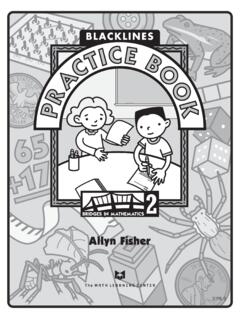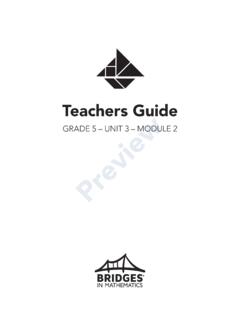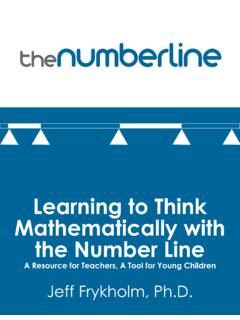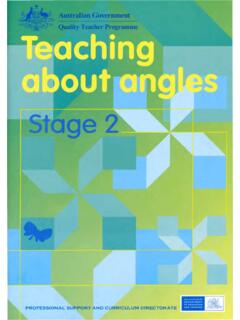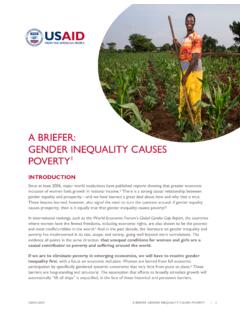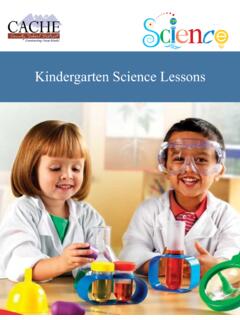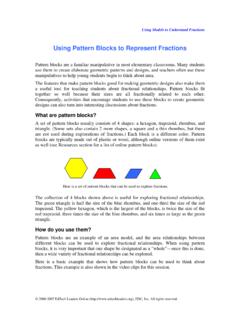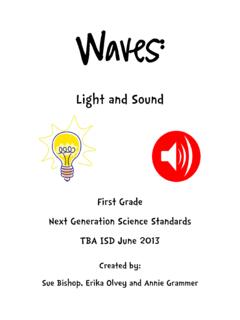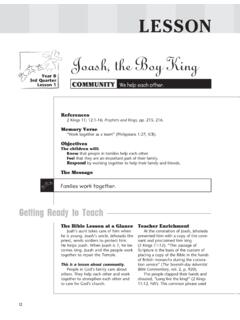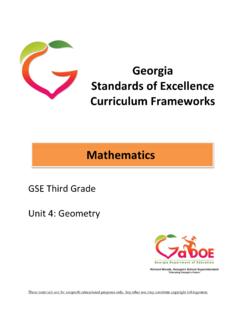Transcription of Pattern Block Lessons - The Math Learning Center
1 Pattern Block Lessons to Meet Common Core State Standards Grades 3 5. Excerpts From Bridges in Mathematics PBLCCSS35. Pattern Block Lessons to Meet Common Core State Standards Grades 3 5. The Math Learning Center , PO Box 12929, Salem, Oregon 97309. Tel. 1 800 575 8130. 2012 by The Math Learning Center All rights reserved. Prepared for publication on Macintosh Desktop Publishing system. Printed in the United States of America. PBLCCSS35 QP1277 P0412. The Math Learning Center grants permission to classroom teachers to reproduce blackline masters in appropriate quantities for their classroom use. Bridges in Mathematics is a standards-based K 5 curriculum that provides a unique blend of concept development and skills practice in the context of problem solving.
2 It incorpo- rates the Number Corner, a collection of daily skill-building activities for students. The Math Learning Center is a nonprofit organization serving the education community. Our mission is to inspire and enable individuals to discover and develop their mathematical confidence and ability. We offer innovative and standards-based professional development, curriculum, materials, and resources to support Learning and teaching. To find out more, visit us at Table of Contents Grade 3. Activity 1 Pattern Block Fractions* 1. Meets CCSS: , , Format: Whole Group Activity 2 Creating Symmetrical Snowflakes 5. Meets CCSS: , Format: Whole Group Activity 3 Sorting Snowflakes by Symmetry 11. Meets CCSS: , Format: Whole Group Grade 4.
3 Activity 1 Pattern Block Symmetry* 17. Meets CCSS: , Format: Whole Group Activity 2 Mosaic Game 23. Meets CCSS: , Format: Center Grade 5. Activity 1 Pattern Block Angles* 31. Meets CCSS: , , , , , Format: Whole Group Activity 2 Angle Measures in Triangles & Quadrilaterals* 43. Meets CCSS: , , , , , Format: Whole Group Activity 3 Angle Measure: From Pattern Blocks to Protractors 49. Meets CCSS: , , , , , Format: Whole Group * Pattern Blocks are the only manipulative required for this activity. Introduction Grades 3 5. Introduction Pattern Blocks and the Common Core State Standards Pattern Blocks are a familiar manipulative available in most elementary schools. We've created this Pattern Block Lessons sampler to help you meet the new Common Core State Standards (CCSS) and organized it in two grade level bands, K 2 and 3 5.
4 The Lessons are excerpts from the Bridges in Math- ematics curriculum, published by The Math Learning Center . We hope you'll find the free resources useful and engaging for your students. The Common Core State Standards (2010) define what students should un- derstand and be able to do in their study of mathematics. A major goal of the CCSS is building focus and coherence in curriculum materials. The standards strive for greater consistency by stressing conceptual understanding of key ideas and a pacing the progression of topics across grades in a way that aligns with what is known today about how students' mathematical knowledge, skill, and understanding develop over time. (CCSSM, p. 4). In addition to the content standards, the CCSSM defines Eight Mathematical Practices that de- scribe the processes the how teachers will teach, and how students will in- teract in a mathematics classroom.
5 Bridges in Mathematics helps teachers meet the challenges of the Content Standards and the Eight Mathematical Practices. During a Bridges lesson , students make sense of mathematics using manipulatives, visual and men- tal models to reason quantitatively and abstractly. They solve challenging problems daily that develop their stamina to carry out a plan and to present their thinking to their classmates. Students make conjectures and critique the reasoning of others, by asking questions, using tools, drawings, diagrams and mathematical language to communicate precisely. Students develop and use a variety of strategies to become computationally fluent with efficient, flexible and accurate methods that make use of patterns and the structures in operations and properties.
6 They use dimensions, attributes, and transfor- mations to make use of the structures in Number and Geometry. Bridges en- courages students to estimate a reasonable answer, and continually evaluate the reasonableness of their solution. This Pattern Block sampler will provide you with examples of Lessons from whole group Problems and Investigations and centers called Work Places. In many cases there are suggestions for sup- port and challenge to help you meet the CCSS standards and differentiate your instruction. The Math Learning Center Pattern Block Lessons to Meet Common Core State Standards Grade 3 5 v Grades 3 5 Introduction Bridges in Mathematics Bridges in Mathematics is a full K 5 curriculum that provides the tools, strat- egies, and materials teachers need to meet state and national standards.
7 Developed with initial support from the National Science Foundation, Bridges offers a unique blend of problem-solving and skill building in a clearly articu- lated program that moves through each grade level with common models, teaching strategies, and objectives. A Bridges classroom features a combination of whole-group, small-group, and independent activities. Lessons incorporate increasingly complex visual mod- els seeing, touching, working with manipulatives, and sketching ideas to create pictures in the mind's eye that helps learners invent, understand, and remember mathematical ideas. By encouraging students to explore, test, and justify their reasoning, the curriculum facilitates the development of math- ematical thinking for students of all Learning styles.
8 Written and field-tested by teachers, Bridges reflects an intimate understand- ing of the classroom environment. Designed for use in diverse settings, the curriculum provides multiple access points allowing teachers to adapt to the needs, strengths, and interests of individual students. Each Bridges grade level provides a year's worth of mathematics Lessons with an emphasis on problem solving. Major mathematical concepts spiral throughout the curriculum, allowing students to revisit topics numerous times in a variety of contexts. To find out more about Bridges in Mathematics visit vi Pattern Block Lessons to Meet Common Core State Standards Grade 3 5 The Math Learning Center Bridges in Mathematics Grade 3.
9 Activity 1. MAGNETIC BOARD. Pattern Block Fractions Overview H Demonstrate that fractions can only Students use magnetic Pattern blocks to be compared when they refer to the model the relationships between parts and same whole ( ). the whole and to find equivalent fractions. H Use the symbols >, =, and < to record comparisons of two fractions ( ). Frequency Incorporate this routine into your calendar H Explain why one fraction must be time two days per week. greater than or less than another frac- tion ( ). Skills & Concepts H Partition shapes into parts with equal H Demonstrate an understanding of a areas ( ). unit fraction 1 b as 1 of b equal parts into which a whole has been parti- H Express the area of each equal part of tioned ( , is 1 of 4 equal parts of a whole as a unit fraction of the whole a whole) ( ) ( , each of b equal parts is 1/b of the whole) ( ).
10 H Demonstrate an understanding of a fraction a b as a equal parts, each of You'll need which is 1 b of a whole ( , is 3 of H Pattern blocks 4 equal parts of a whole or 3 parts H magnetic Pattern blocks (yellow hexa- that are each of a whole) ( ). gons, blue rhombuses, green triangles, H Identify equivalent fractions by com- and red trapezoids, optional). paring their sizes ( ). H magnetic surface (optional). H Recognize simple equivalent fractions H erasable marker ( , Vis- -Vis). ( ). H Generate simple equivalent fractions Note This activity can be conducted at a ( ) projector if magnetic Pattern blocks and H Explain why two fractions must be surface are not available. equivalent ( ). H Write a whole number as a fraction ( ).
